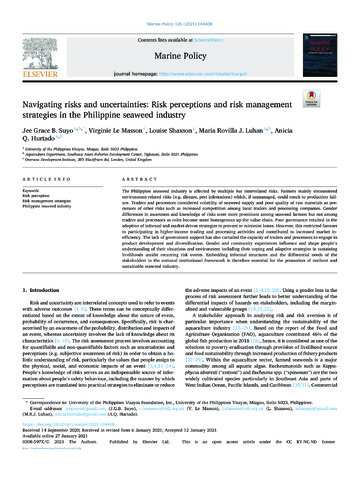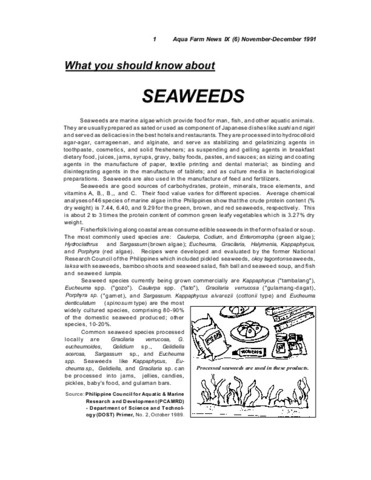Achieving high production of micropropagated seaweed through optimization of the culture protocol
| dc.contributor.author | Sollesta-Pitogo, Hananiah | |
| dc.contributor.author | Faisan, Joseph P., Jr. | |
| dc.contributor.author | de la Cruz-Aranas, Joesyl Marie V. | |
| dc.date.accessioned | 2023-07-21T03:41:28Z | |
| dc.date.accessioned | 2023-07-25T02:20:13Z | |
| dc.date.available | 2023-07-21T03:41:28Z | |
| dc.date.available | 2023-07-25T02:20:13Z | |
| dc.date.issued | 2023-07 | |
| dc.identifier.citation | Sollesta-Pitogo, H., Faisan, J. P., Jr., & de la Cruz-Aranas, J. M. V. (2023). Achieving high production of micropropagated seaweed through optimization of the culture protocol. Fish for the People, 21(1), 12-15. http://hdl.handle.net/20.500.12066/7355 | en |
| dc.identifier.uri | http://hdl.handle.net/20.500.12066/7355 | |
| dc.description.abstract | Kappaphycus and Eucheuma are the two carrageenanproducing red algae extensively cultured and farmed in tropical and subtropical waters. Seaweed production accounted for 5.4 percent of the world’s aquaculture production in 2019, which was over USD 15 billion in value. With this value share, the production of seaweed farming was higher than other aquatic commodities, such as tilapia, carp, shrimps, and others (Cai et al., 2021). The red algae production of the Philippines started in the 1960s (Ronquillo & Gabral-Llana, 1989), and by the early 2000s, the country had become the world’s top supplier of seaweed, particularly Kappaphycus sp., until 2007, when Indonesia outperformed it. Problems and challenges in seaweed farming, including climate change, pests and diseases, and biosecurity issues, caused the continuous decline of the seaweed production yield (Faisan, Sollesta-Pitogo, & de la Peña, 2022). Furthermore, the deterioration of seaweed quality caused by the repetitive use of vegetative cutting methods has also become one of the most pressing concerns in seaweed farming. Unfortunately, this procedure of growing plantlets for farming is one of the most common methods many seaweed farms used in the Philippines and other countries. Research in SEAFDEC Aquaculture Department (AQD) looks into breaking from the conventional method of farming seaweed plantlets and optimizing laboratorybased production. With this, it hopes to create a more sustainable source of propagules, better growth and survival in grow-out, and a higher carrageenan quality in cultured Kappaphycus alvarezii. | en |
| dc.language.iso | en | en |
| dc.publisher | Secretariat, Southeast Asian Fisheries Development Center | en |
| dc.subject | micropropagation | en |
| dc.title | Achieving high production of micropropagated seaweed through optimization of the culture protocol | en |
| dc.type | magazineArticle | en |
| dc.citation.volume | 21 | en |
| dc.citation.issue | 1 | en |
| dc.citation.spage | 12 | en |
| dc.citation.epage | 15 | en |
| dc.citation.journalTitle | Fish for the People | en |
| dc.subject.asfa | seaweed culture | en |
| dc.subject.asfa | seaweeds | en |
| dc.subject.asfa | seaweed industry | en |
| dc.subject.scientificName | Kappaphycus | en |
| dc.subject.scientificName | Eucheuma | en |
| dc.subject.scientificName | Kappaphycus alvarezii | en |
Files in this item
| Files | ขนาด | รูป | View |
|---|---|---|---|
| SP21-1-Achievin ... icropropagated Seaweed.pdf | 444.4Kb | application/pdf | ดู/ |
รายการนี้ปรากฏใน (s)
-
Fish for the People [41]
These articles were contributed by SEAFDEC/AQD staff to Fish for the People Magazine



